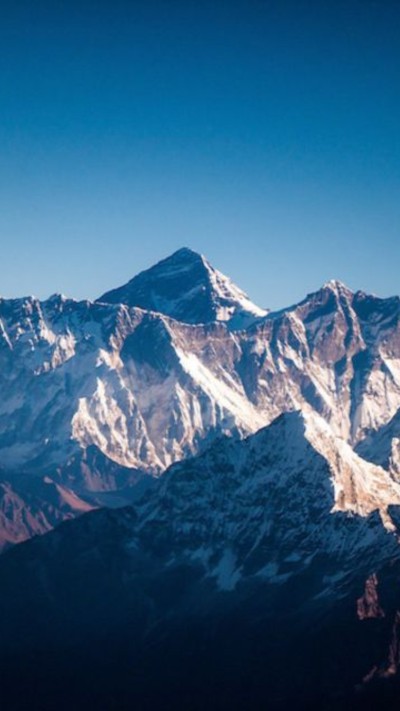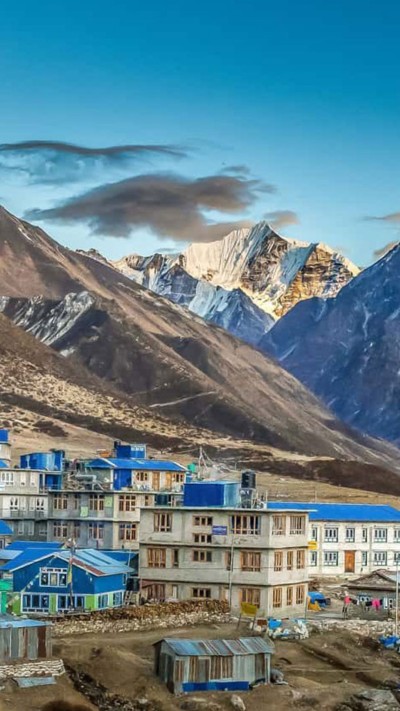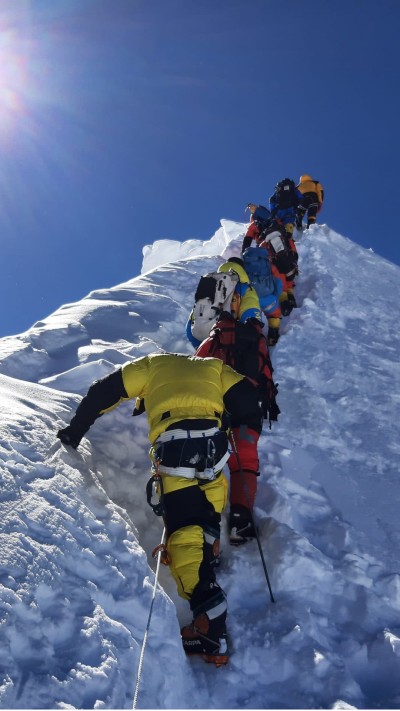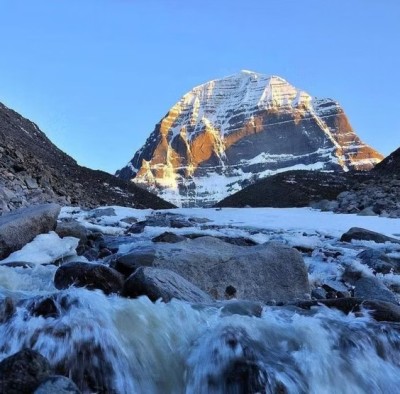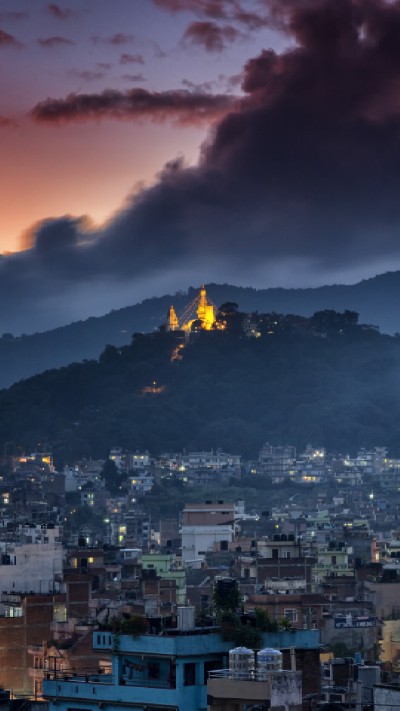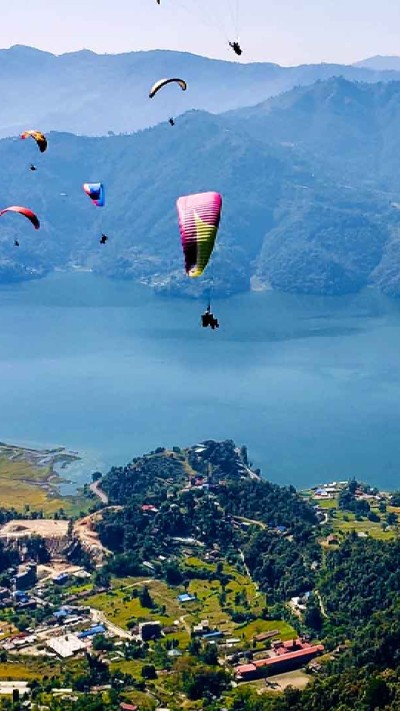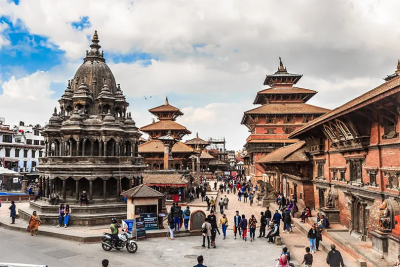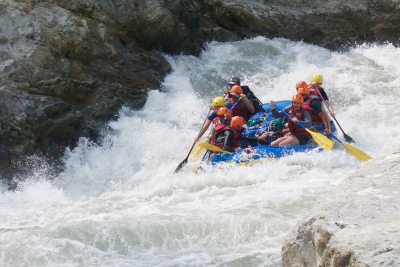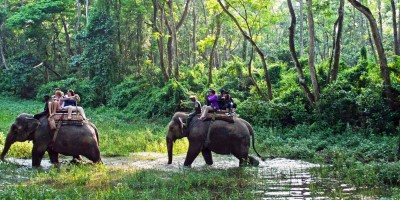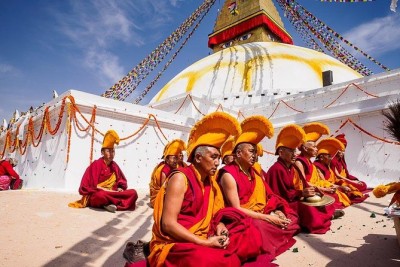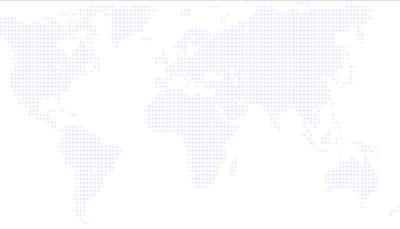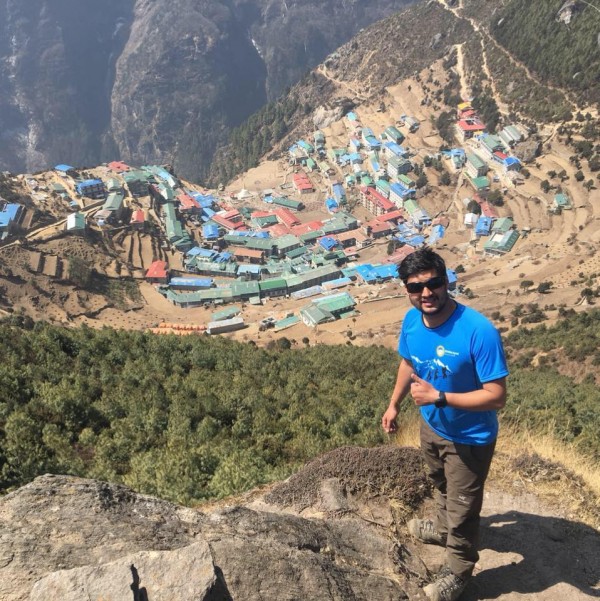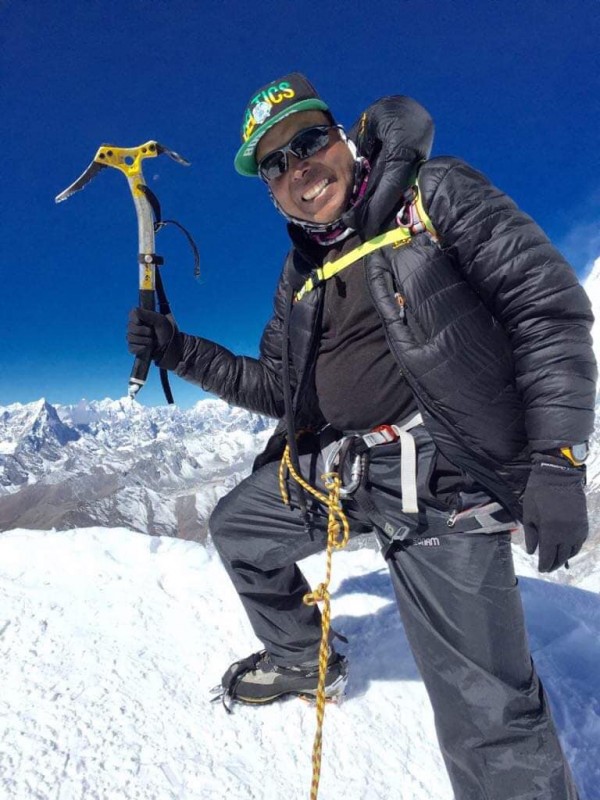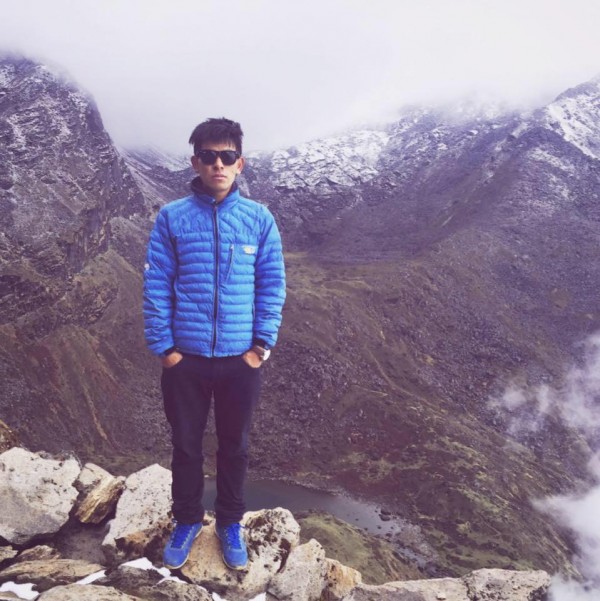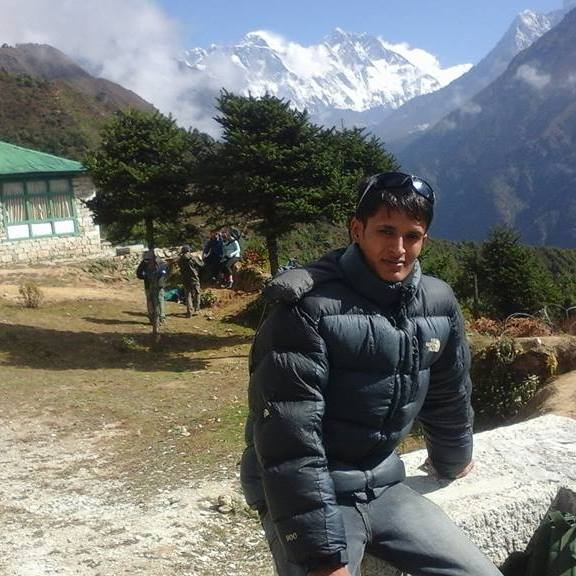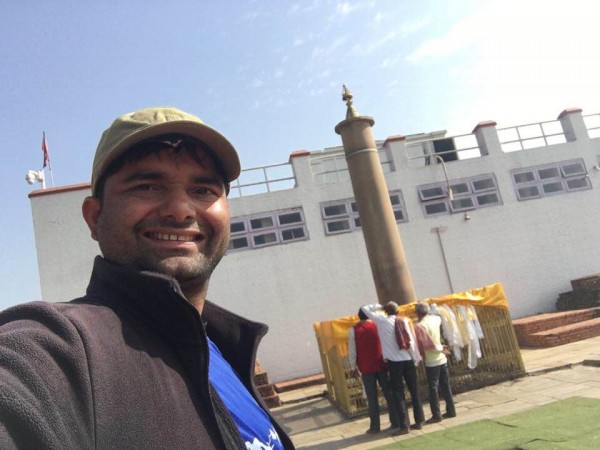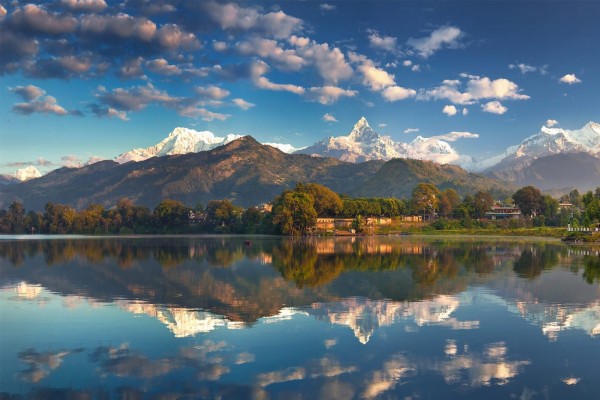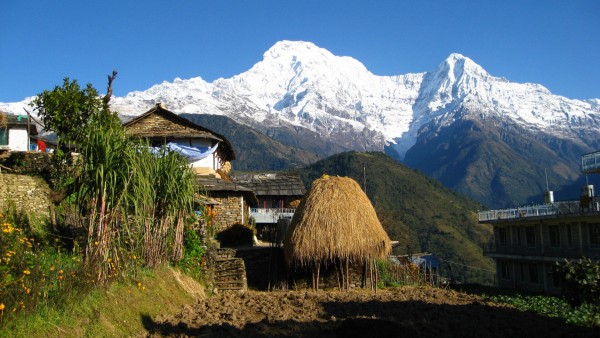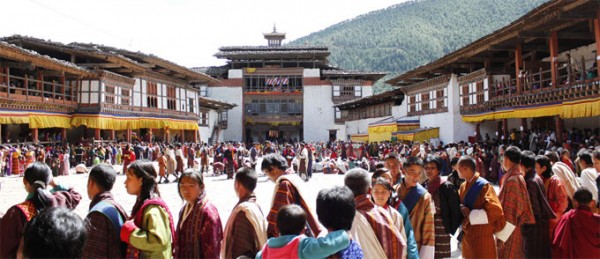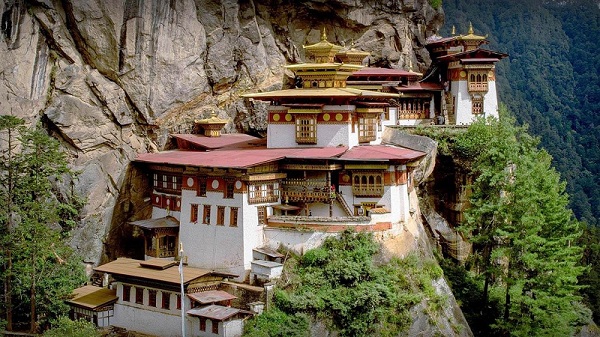Pisang Peak Climbing
Region
Peak Climbing
Duration
18 Days
Max Altitude
6091m
Best Season
Feb, Mar, April, May, June, Sep, Oct, Nov and Dec.
Activity Per Day
5-6 Hours Climbing/Trekking
Transportation
Tourist Bus, Private Car, Plane Flight
Grade
3 Strenuous
Min Group Size
2 people
Overview
Want a thrilling adventure in the area of Annapurna? Then scaling the Pisang peak is a good option. In this area, you should spend about two to three weeks. Pisang peak climbing is a famous adventure of 6000 m, suitable for climbers of all levels. It's a trekking spot for beginners. So the Pisang point is fine if this is your first ascension.
You walk along lovely woodland trails overlooking many mountain tops. The roads are connected to the circuits of Annapurna. You also cross a high pass, Thorong La Pass, when you get to the summit. And on these routes to visit Jomsom and Muktinath, a few famous places.
Pisang Peak climbing is the most popular among the trekking peak climbings of Nepal in the Annapurna region. Trekkers with little experience in climbing can combine the popular classic Annapurna circuit trek with Pisang Peak climbing to have the taste of climbing on the Himalayas in Nepal. The peak rises above from Pisang village and yak pastures in a uniform slope of ice and snow to the final summit pyramid. Pisang peak is considered one of the easy climbing peaks among the trekking peaks in Nepal. To reach the base camp from Pisang village, the path ascends through sparse wood and pasture to a Kharka at (4,380m) which is considered the best place for setting up the base camp. High Camp is set up at (5,400m) climbing to a shoulder on the South-West Ridge.
The highlight of Pisang Peak Climbing
- Climb up the journey of 6000 m high Pisang Peak
- Explore two beautiful and unspoiled valleys: Manang and Mustang.
- Wonderful view of various peaks, including Mount Annapurna, Mount, Manaslu, etc ..
- Taking the Annapurna Circuit routes
- Cross Thorong La, one of the world's tallest mountain passes.
- Visit Muktinath 's Holy Temple
- Endeavor to explore the wonderful region of Annapurna
Outline Itinerary ( 18 Days )
-
1
Arrival Kathmandu
Our representative will wait for you at the terminal until your arrival.
They will greet you at the airport with rebel fighters upon your arrival. Then gather yourself and leave at the hotel. A short presentation will be available before you check in your bed.
Accommodation: Himalayan Suite Hotel
Meal: Dinner
Maximum altitude: 1400 meters above sea level.
Drive Hotel to hotel: 30 minutes -
2
Sightseeing in Kathmandu
After breakfast, our Himalayan Social Journey City tour guide will take you to different UNESCO listed world heritage sites of Nepal. Today, you will visit Pashupatinath Temple or Kapan Monastery, Boudhanath, Swaymbhu, and Patan Durbar square.
Accommodation: Himalayan Suite Hotel
Meal: Breakfast
Activity: Kathmandu sightseeing -
3
Drive from Kathmandu to Chamje
Driving along the sides of the Trishuli river while viewing the beautiful landscapes is quite amazing. Viewing them you drive along the banks of Marshyangdi River. You can see the beautiful hillsides and mountains on these paths. A few years back, the roadways were available only till Besisahar but nowaday it reaches all the way to Chamje. You must be feeling tired after the long drive so get some rest for the next day and stay the night.
Accommodation: Lodge
Meal: Breakfast
Activity: Drive 8-9hrs -
4
Trek from Chamje to Dharapani
The trekking journey from Chamje to Dharapani takes 5 to 6 hours. The route crosses various suspension bridges over the river of Marshyangdi. Traditional Gurung village has a prayer wheel and many terraced farmlands. The highest elevation is 1860m above sea level. The trekking route takes 5 hours to complete. The total distance is 9.25 km.
Accommodation: Lodge
Meal: Breakfast
Activity: Trek 5-6hrs
Altitude: 1860m -
5
Trek from Chame to Upper Pisang
Upper Pisang is a trek along the banks of the Marsyangdi River in Nepal. It offers an astounding view of Pisang Peak and Annapurna II. The trek takes you through coniferous forest and through a small village. It finishes with a stop-off at the village of Dhikur Pokhari.
Accommodation: Lodge
Meal: Breakfast
Activity: Trek 5-6hrs
Altitude: 3300m -
6
Acclimatization Day at Upper Pisang
-
7
Trek to Pisang Peak Base Camp
Today, after a great meal, you head to leave the village. You may be a little happy this day when you head to the Pisang Peak Base Camp. You take the road through the dense forest to Kharka first. This place is pretty perfect for tents. For the night, you camp here.
Accommodation: Camping
Meal: Breakfast, lunch, and dinner
Activity: Trek 4-5 hrs
Altitude: 4380 m -
8
Pisang Peak High Camp
Pisang Peak High Camp is a few hour's walks from Base camp. You will be gaining about 1000 m height this day. The climbing experts will thoroughly check everyone to make sure they are acclimatized to reach the summit. You stay the night at High Camp.
Accommodation: Camping
Meal: Breakfast, lunch, and dinner
Activity: Trek 4-5 hrs
Altitude: 5400m -
9
Summit Pisang Peak and Back to Base Camp
You will be walking through the ridge till the final snow slope. The climb is both technical and steep so walk carefully. You get to see the majestic view of Mount Annapurna, Glacier dome, etc. After exploring and taking snaps you head back to the Base Camp. you stay here for the night. The overwhelming feeling to fulfill the highlights is a memory you won't forget.
Accommodation: Camping
Meal: Breakfast, lunch, and dinner
Activity: Climb/ Trek 7-9 hrs
Altitude: 6041m -
10
Trek from Pisang Peak Base Camp to Manang Valley
From Pisang Peak Base Camp you head to Manang today. You'll walk most of the journey around the shores of the canal. There are beautiful situations around you all the way around.
You arrive in Manang after a few hours of the thrilling journey. It is a beautiful valley and has a distinctive past and culture. The valley full of stone houses can be visited.
Accommodation: Lodge
Meal: Breakfast
Activity: Trek 7-9 hrs
Altitude: 3450m -
11
Trek from Manang Valley to Yak Kharka
Today you 're going from Manang to Yak Kharka. You walk up the hill from the lovely house. The faster the steeper you ascend. As you continue along the route, you continue along with alpine scenery with dense forest and vegetation.
After the trails, in the summer, you enter Yak Kharka, which is a pasture field. It's a small town with a few houses. It is also a spot of rest on the Annapurna Road for trekkers.
Accommodation: Lodge
Meal: Breakfast
Activity: Trek 3-4 hrs
Altitude: 4110m -
12
Trek from Yak Kharka to Thorong Phedi
You 're going from Yak Kharka today to Thorong Phedi. This morning you should continue your walk early. You descend steeply from small settlements up to the river. Then you climb uphill from there onwards.
You will see a lot of breathtaking views of different peaks including Syagang Mountain, Khatungkan Mountain, Gudang Mountain, and several others. You will see Thorong Phedi, Thorong La Pass' base camp.
This village is situated at the foot of Manang's Thorong La Pass. You can visit the areas and search for memories with images.
For the night, you stay here.
Accommodation: Lodge
Meal: Breakfast
Activity: Trek 4-5 hrs
Altitude: 4600m -
13
Cross Thorong la pass towards Muktinath
This day is crucial because you're going through one of the hardest rides.
The view from Annapurna Hill, Dhaulagiri, and several others can be improved. In addition, this location is filled by prayer flags and a few tea rooms. Before midday, your objective is to cross the pass.
You enter the entrance through rugged pathways and thick woodland. You have to watch for the wind whipping violently. After a while admiring the majesty of the landscape and the mountains, we continue.
We reach Muktinath by trekking down there. For Buddha and Hindu disciples, this is a holy shrine. Thousands attend this temple every year.
Accommodation: Lodge
Meal: Breakfast
Activity: Trek 7-8 hrs
Altitude: 3800m -
14
Trek from Muktinath to Jomsom
You wake up and tour the temple early today. You will bathe and see the everlasting flames in the 108 ponds. It is said that once you take a bath in the holy water, your sins are forgiven by the 108 waterspouts. After a stroll around the temple, you take photographs and enjoy the view to your house. Starting here you can walk this day to Jomsom.
Jomsom is a lovely village where the Thakali community lives. This is a major gateway to Upper Mustang and Muktinath. For the night, you live here.
Accommodation: Lodge
Meal: Breakfast
Activity: Trek 5-6 hrs
Altitude: 2760m -
15
Flight from Jomsom to Pokhara
Heading to Pokhara from Jomsom, you will take an early flight today. The flight from here is roughly half an hour. Boarding the ship, you hit your destination with lovely scenarios. Pokhara is a lovely city and one of Nepal's most popular tourist centers. This is an ideal place for both tourists and domestic visitors. Throughout your stay, there are numerous wonderful places to visit.
Lake Phewa, Cave Cat, Mahendra Cave, etc. Walking along the lakeside in the evening is quite an experience. The markets are lined with stands and tourists to wander about in late evenings.
Accommodation: Hotel
Meal: Breakfast
Activity: Flight 20min and Pokhara sightseeing
Altitude: 820 m -
16
Drive from Pokhara and Back to Kathmandu
You are going to say farewell to this lovely place, with wonderful memories. You 're waking up and boarding the bus. Follow the routes through the Prithvi Highway via small villages. You fly back to Kathmandu to look at the magnificent hills and river Trishuli. You'll be dropped off at your hotel when you arrive in Kathmandu.
Accommodation: Hotel
Meal: Breakfast
Activity: Fly 40min / drive 8-9 hours to Kathmandu
Altitude: 820 m -
17
Rest Day in Kathmandu
-
18
International Departure
Our representative will come to pick you up for your transfer to the Airport. You will be heading back to your home country after breakfast.
It was a pleasure to have you with us on this incredible trip.
Meal: Breakfast
Include
- All surface transfers as per itinerary.
- 4 nights stay in Kathmandu & 1 Night Stay in Pokhara with BB Plan
- Fooding, lodging, insurance and other expenses of trekking crew
- Liscened and experienced Guide
- Tims and national park fees
- Necessary equipments ( Jackets sleeping bag and trekking pole and climbing equipments) during the trek.
- Trekking cook, kitchen staff, Trek Sherpa and other support staff.
- All camping equipment - 2-person member tent, dining tent, kitchen tent, staff & porter tent, toilet tent with commode, dining table with backrest chair etc.
- Proper Insurance of all staff including porters.
- Farewell and Welcome dinner in Kathmandu
- Domestic flight from Jomsom to Pokhara
Exclude
- Lunch and dinner in Kathmandu and trekking days (Except during camping days while climbing)
- Your Insurance, Personal equipment, and clothing
- Cold drinks and beverages
- Your travel insurance (Compulsory)
- City sightseeing entrance fees
- Flight fare from Pokhara to Kathmandu (USD 110PP)
- Rescue operation
- Special Climbing Permit Fee
Best Time to climb Pisang Peak
Visiting Pisang Peak is suitable at any time of the year. There are four seasons: Spring, Autumn, Monsoon, and Winter. Spring and Autumn are the peak season when nature blooms the valley with its beauty. During these seasons the days are sunny and hot while the nights are mild. Winter and Monsoon are also doable but there are a few obstacles. These are seasons of snow and rainfall.
Acclimatization
Altitude sickness is worrisome and feared by numerous adventurers and will require quick treatment and shouldn't be left disregarded. Height infection is preventable however can be deadly if the side effects are overlooked. Our outing agenda is intended for gradual rising so the body can adjust to the new elevation In this journey, we will take a rest day for acclimatization at peak Base camp where we will climb the edge to investigate the staggering scenes on the pinnacles. We will be taking a ton of rest all through the undertaking. During your rest days, you will be taking a shot at recuperating, eating and drinking, to peruse, unwind, tune in to music and walk around visiting different groups.
Our guides and porters are very much prepared, trained, and experienced at high height and they have broad emergency treatment Training too. Your wellbeing and security are imperative to us and we ensure that it will be our absolute primary goal. In the event that you have been affected by altitude sickness, the main fix is to climb down right away. Likewise, realize that your group leader that is your guide has the conclusive duty to choose whether you can proceed with the trip dependent on your general health conditions.
Level of Peak Climbing Skills required
Pisang peak requires a moderate degree of specialized ascending skills. It is intended for vigorous and genuinely fit travelers with next to zero involvement with mountain campaigns with minimal specialized aptitudes required. Pisang The peak isn't hard for amateurs who have trekking experience in the mountains of high altitude. The excursion is entirely appropriate for any gutsy spurred adventurers who have the capacity to stroll in snows edges and trails. in the event that you have any related knowledge in 7000m mountains or just appreciate Peak Climbing, it will be a bit of leeway for you. Additionally, you should have a strong determination and want to ascend the mountain. As for the authority, strategies, and by and large dynamic during the ascension, we have prepared profoundly experienced aides and endeavor staff.
Age doesn't make a difference as long as you meet the wellbeing and aptitudes necessities. By and large, we have individuals from ages 20-60 going along with us for Trekking and Peak Climbing on higher altitudes.
Peak Climbing Grade: Fitness level, Medical, and Health
The Pisang Peak Climbing is a difficult for first-timers yet compensating journey with more value to scenes, experiences, and thrill. The Peak Climbing will be from 5 to 7 hours daily depending on the goal, taking normal breaks where we appreciate the mountain scenes. The trip courses include long ascensions, steep drops, and precarious trails in the rough ways and the woods also. To go on such trips, the fitter you are physical, the more agreeable and charming the excursion will be. In the event that you have an experience of peak climbing or a strong desire for Peak Climbing, this might be a bit of leeway for you. This journey isn't recommended to individuals who suffer from heart or lung sickness.
We have medically trained staff at the basecamps to screen your wellbeing all through the journey and every base camp is outfitted with medical types of gear and provisions. All our aides and pioneers leading the trip have medical training and the ability to care for you effectively.
What to expect during peak climbing?
A day on traveling will be an extraordinary day as a result of the delightful mountains. You will get an opportunity to appreciate the view, click pictures, and investigate the neighboring towns. Your journey will be joined by experienced, amicable, and qualified aides alongside watchmen to convey your baggage.
The day starts with early morning breakfast. At that point, we gather our packs and set off to trip to our goal between 7 to 8 am relying upon the term of the journey every day. We will travel for 3 to 5 hours before we enjoy a short reprieve. Lunch will be given around the early afternoon. A portion of our group leaves ahead to reach the overnight cabin to do some planning. Supper is given around 6 to 7 pm. Prior to hitting the hay, we will talk about the day's understanding and plan for the following day. We will appreciate and engaging ourselves and it is really up to the individuals on the off chance that they need to go along with us as they may want to rest. During the ascension, the schedule relies upon the climber, climate, and course conditions. We will consistently pick the more secure choice. We will cross troublesome ice shakes a few days will incorporate steep snow Peak Climbing. Some days we will utilize fixed rope courses. For our trip our exceptionally experienced Peak Climbing guides fix new ropes to guarantee safe rising with jammer and saddle for the difficult and provoking move of 100 meters to the highest point edge. If things go well we will be at the highest point following after 3 days of leaving the base camp.
Accommodations and Meals
Tea houses/lodges are accessible during the trek (except the climbing time on Pisang Peak). And we must build a camp for our lodging during our climbing time for a few days. We must also sell both tea rooms and camping facilities in areas where tea/lodges are inaccessible. Single, two, three, or twin shared accommodation can be provided according to the requirement.
Pisang Peak Climbing is a bed and breakfast basis package. You will get breakfast every day from the beginning of the trek. Lunch and dinner are excluded until the peak climbing days. Dinner and breakfast will be eaten in the same camp/tea room, where we have spent the night and lunch will be on our way to the next destination as we have to leave after breakfast to begin our trek. You would be able to sample the varied food; Nepalese, Tibetan, Continental, Indian, Italian, etc. by choosing from the menu.
During the camping season, our catering staff prepares hygienic food to serve you when on Yala Peak Base Camp and High Camp. All meals ie, breakfast, lunch, and dinner will be included and prepared by our staff. During the camp, there can be no choice of food such as tea houses and restaurants. You will understand that our crew must bring from available places all items including camping gear and kitchen appliances. Our team can ensure that you have memorable interactions, even with minimal choices.
Telecommunication and internet connection
Telecommunication services on the higher altitudes are limited. The connectivity is strong and reliable at lower altitudes. It gets rarer and weaker as you go higher.
GSM and CDMA connectivity of NTC and Ncell is available with an Internet connection. Wi-Fi connectivity is a distant wish. This is a wilderness trek, so enjoy a few days of your life away from the Internet connectivity.
Most of the area below 3,000m, the cell phone works partially. while satellite phones are available in camp once you reach the upper ground.
For any emergency situation, our guides are equipped with satellite phones. So you are a call away from emergency response. The absence of a telephone connection should not make you nervous.
Drinking-Water
During peak climbing a sufficient amount of water would be needed to carry all the way. However, until the base camp filling up water is quick. Taps in, out, or in guesthouses mean that there are plenty of places to fill your bottles and/or your water bladders. This could be where you stay, a lunch stop, or a shared public tap used by locals wherever possible. Use an efficient sterilization method to make sure your water is safe and not contaminated in any way.
Electricity and connectivity
You will be staying overnight in the tea houses during your trek. These are small lodges with a common area and a cabin. You can have your food or charge electronics in the community, sometimes use wireless internet, and chat with walkers.
Hot water and electricity do not occur in every tea house. Showering is a luxury and shouldn't usually be done anymore at an altitude of 3,500 m, because warming will be hard when you take a shower again.
You would need to pay additional for all the above items (dusches, hot water, electricity, and wifi).To improve your connectivity, carry your phone to the Nepal SIM, you'll get more than you'd think (GPRS/EDGE speed). The village's electricity could be perfect during your stay. Villages above 4000 m tend to be the latter. Tea houses can have the potential to charge you either from solar sources or from a battery bank. but it is most wise to either have your own or not depend on electronic devices.
Trekking Permits
You will need to arrange both the Trekking Information Management System (TIMS) permit and the Langtang conservation area permit. You will need special permits for peak climbing and expedition by NMA which is not included in the total trip cost HSJ will arrange for your trekking permits.
These will need to be checked at different checkpoints along the trek.
Make sure you also bring a minimum of 4 passport photos for your trekking permit!
Garbage deposit for all 33 NMA Peaks
And the amount of US$ 250.00 should be deposited to NMA as garbage deposited to get a permit to all 33 NMA peaks.
The refund shall be made as per the provisions made by NMA.
Travel Insurance
For this trek and peak climbing taking out an insurance plan for your individual accountability, accidents, and illnesses during the service are compulsory.
Regarding the type of activity, you may be asked to show a certificate of insurance for help and support, sanitation, and search. This service is private and not free in Nepal, the helicopter will not take off until it is convinced to pay for the insurance.
Extra Expenses
It’s difficult to give an exact amount of money that you should bring. Costs will vary according to how much you want to spend. Trekkers find that around $20 a day is reasonable for the trekking days. You would also have to pay for hot showers, Wi-Fi, and charging.
Solo Traveler
There will be two people accommodated in each room for the duration of the tour. If you prefer private accommodation, you'll find the option for a "single supplement" of USD 350. Important: Please note that during the trek there are some lodges which won't have sufficient rooms to provide private accommodation. So, even if you purchase a single supplement you will end up sharing a room for some days of the trek.
Travel and Transportation Modes
By Bus: Touring to and from city destinations is done on a private vehicle such as a car, jeep, or microbus. Luxury tourist buses, which are only hired by the company, for the most part, make the long-distance travel. You will have to take a public bus on some trip, but you do not need to worry about your protection or comfort because you ride with our guides and support staff in a group.
Equipment and Packaging list for Langtang Base Camp
Clothing
- Trekking boots
- Short-sleeved Trekking shirts
- Trekking pants and jackets
- Thermals underwear
- Long-sleeved Trekking shirts
- Insulating down jackets
- Woolen cap
- Trekking Gloves
- Raincoats
First Aid
- Diamox tablets
- Sanitary pads / Tampons
- Anti-nausea Medicines
- Band-aids
- Mosquito and insect repellents
Toiletries
- Soap
- Toilet Paper
- Shampoo
- Sunscreen
- Hand sanitizer
Accessories
- Sunglasses
- Sleeping bag
- Cameras
- Batteries
- Water Bottle
- Solar Chargers
- Hot water Thermos
Important Documents
- Passport
- Travel Permits
Peak climbing gears
- Climbing Helmet: Choose a good quality climbing helmet. Make sure your warm cap fits under your helmet.
- Climbing Boots: High altitude, Insulated stiff-soled climbing boots.
- Crampons: C2 crampons that fit the climbing boots.
- Climbing Harness: Good quality climbing harness.
- Ascending device or Jumar
- Descending or belay device
- Tape sling: UIAA tested 220cm open tape sling or 2 x 120 cm closed tape sling
- Carabiners: 2 x lockable carabiners. 2 x non-locking carabiners
- Prusik loop: Best quality prusik loop
- Ice ax: An ice ax with a wrist strap for climbing
This Tour with HSJ
Guides and Porters
Our local Nepali team is one of the most experienced, hospitable, and respected trekking outfits in Nepal. The team is fully licensed and affiliated with the Trekking Agency's Association of Nepal (TAAN), Nepal Mountaineering Association, Nepal Tourism Board, Govt. of Nepal, Sustainable Tourism Network, Himalayan Rescue Association, and Kathmandu Environmental Educational Project. You will be provided with the professional and an experienced English speaking trekking guide with the good knowledge of the place and the trek. The trekking crew is skilled with the experience of over 10 years, well-trained, friendly guide and, courteous and helpful porters, assured of a wonderfully memorable experience.
For the trek, we'll have one porter for two people as per group size. The porter will carry 12-15 kg per person luggage during the trek. You need to carry your day pack to keep your personal belongings such as wallet, camera, water bottle, dry snack, headlight, gadgets, etc. The safety and concerns of our porters are our collective responsibility. We take our responsibilities towards them and their safety concerns strictly. On your part, please carry only things that are of absolute necessity.
Your baggage ought not to be in excess of 15 kg and will be carried by the porters. Porters and Yaks will just go with us until they leave our gear with us at the base camp and leave us for a couple of days during the climbing time frame. You will be liable for your own gear during the ascension. Travelers will bring a backpack or duffel bag to carry water, cameras, bathroom tissue and comfortable garments, and climbing gears. During the ascension, climbers must carry their own gears and are suggested to keep any unnecessary or access stuff at your lodgings, and you can get it back after the journey.
Other Programs and complimentary services with this trip
• Welcome and Farewell dinner
• Yoga Classes
• Spa services
How do we make sure you get the best experience of this trek?
We are your completely flexible travel partner. Want to follow different routes? We have you covered. Have extra time in Nepal? Excellent! We have more add-on tours like Chitwan Jungle Safari, Cable Car ride to Chandragiri hills, Cooking and Yoga classes in Kathmandu, and so on. Would like to customize the trip? Well, why not? Give us your ideas and we will prepare a complete itinerary for you. Do you want to use a different standard of accommodations than provided in the itineraries? Of course! You absolutely can. From your arrival until you depart, your wishes are our command. Feel free to make the request.
Last-minute booking
It is best to book in advance but for those who cannot, for whatever reason, make a last-minute reservation special arrangement for Himalayan Social Journey. In the case of last-minute reservation, 100% tour payment will be approved within 24 hours. We try to operate a trek at any time but we are not liable for the delay in case of last-minute reservation, because of uncontrolled changes such as weather and the availability of accommodation.
Feedbacks
Throughout the years of business, we have always put the customer's feedback as our inspiration towards making our company a great travel partner. With many ups and downs, and good and not so good feedbacks we have reached where we are now. At the end of the trek, while you are with the crew during farewell dinner, we would appreciate it if you give us your valuable feedback, an account of good and bad experiences, recommendations, and also your honest rating to our trip advisor page.
Important Information
The best time for climbing is during the months of April, May, September, and October in November.
The temperature is favorable during these months. The night is less windy and the days sunny. The weather is not very cold as in winter and no big plumes as in Monsoon.
Extra time:
It is easier to add extra time while preparing your journey to Peak Climbing. The climatic conditions in the mountains you will never know about. Your flights could be delayed or canceled due to bad weather. Also, you may have to rest a few days at lower altitudes when you suffer from high altitude sickness.
Schedule for Acclimatization
It will be difficult to reach an altitude above 6000 m, so the right amount of acclimatization is important. Air-conditioning is performed to allow the body to respond strongly to the surroundings. Before you climb up, you need to give your body proper rest.
Adequate preparation
Before you begin this journey, your mind and body should be well prepared. A great deal of energy is required as the steep paths are ascending. The last steep ascent through the headwall is the most exciting part. You can conquer them by preparing properly.
Verify your equipment
In guaranteeing your health, gear plays a key part. To hit the top, you will need numerous mountain gears and kits. You can rent in Kathmandu, but it can be average. You must also properly test your equipment such as they don't break on storm and snowfall.
Research on weather, risks, and also check on some surviving tactics and techniques in extreme conditions.
You will be trekking for 5-7 hours a day depending upon the landscape and destination.
You need physical and technical training before you start your journey. A mountaineer should be well aware of the entire journey.
On this climb, you bring the mountain equipment like ropes, crampons, harness, etc. These gears are critical for fast and safe climbing.
You will camp to adapt to the camping life and, if possible, to use the facilities. This helps to increase the understanding of how to deal with them.
You should do some physical activity before climbing. For example, walking, swimming, cycling, etc.
You reach the summit without hesitation with proper preparation and acclimatization schedules.
You will need to arrange both the Trekking Information Management System (TIMS) permit and the Sagarmatha National Park Permit. You will need special permits for peak climbing and expedition which is not included in the total trip cost HSJ will arrange for your trekking permits.
These will need to be checked at different checkpoints along the trek.
Make sure you also bring a minimum of 4 passport photos for your trekking permit!
|
MONTHS |
MARCH-APRIL-MAY |
SEPT-OCT-NOV |
DEC-JAN-FEB |
JUNE-JULY-AUGUST |
|
PERMIT FEE (USD) |
250 PP |
125 PP |
70 PP |
70 PP |
Garbage deposit for all 33 NMA Peaks
And the amount of US$ 250.00 should be deposited to NMA as garbage deposited to get a permit to all 33 NMA peaks.
The refund shall be made as per the provisions made by NMA
Travel insurance & rescue when travelling to a remote destination like Nepal is strongly advised. It should provide adequate protection for the full duration of the tour. Your insurance policy must cover all the activities that you will be undertaking during your stay in Nepal such as helicopter rescue, cancellation, air ambulance, injury, death, lost baggage, theft, liability, medical treatment, and cover repatriation and personal expenses. If a client becomes ill, all hospital expenses, doctors’ fees, and repatriation costs are the client’s responsibility. For reliable travel insurance, we have the suggestion of some of the best insurance companies: Cover more or Europe assistance or Travel Direct- TID. We have an agreement with the Helicopter Company to do the payment of Helicopter evacuation after we collect the payment with you once you have been rescued. And the reimbursement responsibility from your insurance company will go up to you. Be sure your policy specifically covers helicopter evacuation and does not exclude mountaineering or alpinism
The insurance of the guide and porter is covered by the company. All our guides and porters are properly insured.
Your baggage ought not to be in excess of 15 kg and will be carried by the porters. Porters and Yaks will just go with us until they leave our gear with us at the base camp and leave us for a couple of days during the climbing time frame. You will be liable for your own gear during the ascension. Travelers will bring a backpack or duffel bag to carry water, cameras, bathroom tissue, and comfortable garments and climbing gears. During the ascension, climbers must carry their own gears and are suggested to keep any unnecessary or access stuff at your lodgings, and you can get it back after the journey.
You need to train your body and brace yourself for 8-10 hours a day in all weather conditions, to walk on a rugged terrain of 8-20 km. You're going to walk both below and above the average altitude of Nepal. Trekking under the hot sun and the chilly cold nights is also likely.
Training makes the journey less complicated, safer, and more pleasant. So before you go on a trekking experience, you need to spend longer and more effort training. The best way is to get to the top stairs that take one or two minutes. Till you puff, you can do 10 sets. By putting on a backpack from 5 Kg to 20 Kg, you can add strength. Your heart and lungs will become healthy by doing so. One thing you have to remember is that before you start the training program you still have to warm up and stretch. Cycling running, jogging or hill climbing may be another aerobic exercise. Or you can choose any exercise in the aerobic range (70% of your maximum heart rate).Aerobic activity protects the heart and reduces the risk of stroke and heart attack. It also strengthens your lungs. It enhances breathing, endocrine, muscle tones, and strengthens bones.
On the trek, we'll be staying at simple lodges run by Nepali families. During the trek, the bathrooms are outside the rooms and hot water is dependent on solar panels so don't count on many warm showers.
Most teahouses (lodges) in Annapurna region trails cook a delicious range of mostly vegetarian fare. Pasta, tuna bakes, noodles, potatoes, eggs, daal Bhat (rice and lentils), bread, soup, fresh vegetables (variety depends on the season), and even some desserts like apple pies, pancakes, and some interesting attempts at custard. You will find a lot of garlic on the menu because it assists with acclimatization – eat some every day. In many villages, you may find some meat items on the menu. You can always get hot chocolate, tea, and hot lemon drinks, as well as soft drinks, and treats like chocolate and crisps.
During the camping season, our catering staff prepares hygienic food to serve you when on Base Camp and High Camp.
Yes, All required Climbing gears, tents, plastic climbing boot, crampons, climbing rope, ice- ax, zoomer, harness, the figure of eight, carabineer, etc will be provided by the company which you have to return back after the end of the trip.
FAQ's
There are three ways to get a visa for Nepal
- Visa on arrival: You can get a visa on arrival at the Tribhuvan International Airport in Kathmandu or other designated entry points. The visa fee is USD 30 for 15 days, USD 50 for 30 days, or USD 125 for 90 days.
- Online application: You can apply for a visa online through the Nepal Immigration website. https://nepaliport.immigration.gov.np .The visa fee is the same as for visa on arrival.
- Nepalese Embassy or Consulate: You can also apply for a visa at a Nepalese Embassy or Consulate in your home country. The visa fee may be different, so check with the embassy or consulate.
Visa requirements
- Passport valid for at least six months from your planned entry date into Nepal.
- Visa application form.
- Passport-sized photo (Bring 4 )
Gratis Visa (Visa for Free)
Gratis Visa is issued free of cost in case of following categories of Visa applicants:
- Children below 10 years except US citizens
- Up to 30 days for SAARC Citizen - Bangladesh , Bhutan, India , Maldives , Pakistan , Sri-Lanka (except Afghanistan) visiting Nepal for the first time in a given visa Year. Afghan citizen are eligible for Gratis Visa on Arrival only upon the recommendation of Department of Immigration. If you are an Afghan citizen, you can request concerned institution inviting you to Nepal for necessary paperwork with Department of Immigration to get you Gratis Visa 'On Arrival'.
- Non Residential Nepalese(NRN) card holder ( issued by MoFA /Nepalese diplomatic missions abroad)
- Chinese Nationals for 150 days
Nationals of following countries are requested to acquire Visa prior their arrival from their nearby Diplomatic missions (Embassies/consulates) of Nepal Government.
- NigeriaGhana
- Zimbabwe
- Swaziland
- Cameroon
- Somalia
- Liberia
- Ethiopia
- Iraq
- Palestine
- Afghanistan
- Syria
- Refugees with travel document
If your passport is not valid for at least six months, you will need to renew your passport before you travel to Nepal. You can renew your passport at your local passport office. The process of renewing your passport can take several weeks, so it is important to start the process early.
By air:
Nepal has Three international airports: Kathmandu, Bhairawa, and Pokhara. Currently, Pokhara airport does not handle international flights. However, there are a few flights to Bhairawa from few countries. The main international airport in Nepal is Tribhuvan International Airport (TIA), located in Kathmandu. You can search TIA airport to book your International flight.
By land: There are multiple land entry points along the borders of Nepal, India, and China. These entry points include Kakarvitta, Birgunj, Bhairahawa, Nepalganj, Dhangadhi, Mahendranagar, and Kerung(china boarder)
If you've booked a multiday tour or trekking package with Himalayan Social Journey, we'll pick you up from the airport. Upon arriving at Tribhuvan International Airport in Kathmandu, our representative will be there to greet you with a sign displaying your name and our company's name. We'll then take you to your pre-booked hotel.
To make the pick-up process smooth, kindly share your flight details, including flight number and arrival time. If there are any changes to your arrival plans, please inform us as soon as possible so we can arrange your pick-up accordingly. Travel with us for a hassle-free experience!
Please keep this thing in your mind that there are some airport touts and scam artists who take advantage of tourists. They might offer to carry your luggage and they want a large amount of money. Sometimes they intimidate our drivers and even take away their signs. Anyway...if you want someone to help you with your luggage you can give them NOT MORE THAN 1 - 2 DOLLARS. This is a small hassle that tourists sometimes face upon arrival at the airport. Do not stress about this but just be aware not to give more than a few dollars for their luggage handling if you choose to take someone's services. Nepalese in general are very kind and hospitable people.
The official currency of Nepal is the Nepalese rupee (NPR). Major foreign currencies such as USD, AUD, and EURO are accepted for VISA.
There are plenty of ATMs in these major cities, so you can easily withdraw cash from your foreign currency bank account. Credit cards are also accepted in some shops and restaurants, but they are not as widely accepted as cash.
On the trek, you will only need to use Nepali rupees. You can exchange your foreign currency for Nepali rupees at your hotel, money exchanges, or the airport. Himalayan Social Journey representatives will also be happy to help you exchange money.
If you have booked a trekking or multi-day tour with Himalayan Social Journey, the orientation meeting usually happens at your Kathmandu hotel around 4 or 5 pm. Our team will provide you with the specific details upon your arrival.
If you're arriving early or leaving late, please ensure to arrange extra hotel accommodations by contacting reser[email protected]. Let us know if you'll be extending your stay in Nepal, and we'll book your additional nights. Also, kindly share your flight details with us to facilitate a smooth pick-up and drop process.
When you book a trip with us, the standard accommodation arrangement is on a twin-sharing basis. This means two people will be staying in each room throughout the trip. However, if you prefer to have a room to yourself or if you're traveling alone, you can choose the "single supplement" option. By selecting this option, you'll have a private room during the trip, but please note that there will be an additional cost for the single room arrangement according to tour / trek.
For each tour date, there will be several separate groups, each with a maximum of 14 people and their own experienced English-speaking guide. During the trek, there will be a suitable number of porters available to carry your luggage. Additionally, if you prefer to do a private tour or trek with your own group, that is also possible.
Nepal has five main seasons: summer, monsoon, spring, autumn, and winter. Each season offers unique experiences and weather conditions.
Winter (Late Dec - Feb): Cold temperatures, great for festival tours and special highlights.
Spring (Mar - May): Magical rhododendron blooms, ideal for trekking and peak climbing.
Monsoon (Jun - Aug): Low season with rain, but perfect for nature lovers and discounts on hotels.
Autumn (Sep - Nov): Peak season, clear weather, and popular trekking regions fill up fast.
You can check the live weather condition via this website https://www.accuweather.com
The hotel in Kathmandu where you'll stay during the trip offers complimentary storage services. You can leave your luggage and extra clothing that you won't need for the trekking / tour. Rest assured, you can collect them once the trek and tour are over.
Don't forget to bring both TWO and THREE-pin travel adapters! If you don't have them, you can purchase them at supermarkets or electronic shops in Kathmandu. Our guide will be there to assist you if needed. You can get information about plug and voltage in below link.
Most places in Nepal are covered by mobile network providers, especially Ncell and Nepal Telecom. You can use data services for communication. You can buy a SIM card at the airport counter. There are also free and paid Wi-Fi services in most tea houses in Nepal during trek.
Here are some tips for staying connected while you are in Nepal:
- Buy a SIM card as soon as you arrive in Nepal. This will give you access to data services and allow you to make calls and send text messages.
- Check the coverage map of your mobile network provider before you travel. This will help you to know where you can expect to have good reception.
- If you are planning on visiting remote areas and need to be in connected on Internet , you may want to consider renting a satellite phone. This will give you access to communication even in areas with no mobile network coverage.
- There are many free and paid Wi-Fi hotspots in Nepal. You can find these at hotels, tea houses, restaurants, cafes, and even some temples.
If you would like to book extra activities such as Paragliding, Bungy jump, Mountain flight, Heli Tour , Bhaktapur Sightseeing many more programs. You can find updated price and program detail in this link: https://hsj.com.np/tourtype/daytours. You can book by contacting us at [email protected] For longer excursions such as Bhutan, Tibet, India, and any other treks also, we can help but please contact us immediately at [email protected]
If you have purchased a voucher from any deal company, please come in contact with us with the voucher code (redemption code) so that the voucher can be redeemed on time. Since we need time to purchase your domestic air ticket and make other arrangements, kindly confirm your spot with your suitable date at-least 2 months prior to the commencement of the tour. Your booking on a particular tour date is subject to availability of spots. You can redeem you voucher through this link too : https://hsj.com.np/voucher-redemption
A typical suggestion for tipping is to allocate around USD 50-60 for the guide and porter if you're happy with their service. However, the amount you decide to tip is entirely up to you, and you can give whatever you feel is appropriate based on the excellent service they provided during your tour / trek
Packing List for Tour:
Pack appropriate clothing for the weather conditions during your visit. Include comfortable walking shoes, a hat, sunglasses, sunscreen, and insect repellent. Don't forget essential travel documents, a camera, and any necessary medications.
Packing List for Trekking
Hiking
- Trekking Poles - 1
- Daypack - 1
- Backpack - 1
- Packcover
- Water Reservoir - 1
Sleeping
- Sleeping bag - HSJ will provide
- sleeping bag liner
Clothes
- Underwear - 3
- Socks - 3
- Bra - 3
- base Layers pant - 1
- Trekking Tshirt - 3
- Trekking Pants - 2
- Rain Pants - 1
- Hiking Shoes/ Boots - 1
- Gloves - 1
- Hat - 1
- Down Jacket - 1
- Wind Breaker - 1
- Sandles -1
Miscellaneous
- Sunglasses - 1
- Books or E-reader (optional)
Hygene/Saftey
- Microfiber towel - 1
- Toothbrush - 1
- Toothpaste - 1
- First aid kit - 1
- Medicine kit -1
- sunscreen -1
- sewing kit -1
- Soap/shampoo - 1
- Comb or brush - 1
- Period supplies - 1
- Toilet paper - 1
- sanitising gel - 1
Electronices
- Camera
- Phone
- Extranel Hardrive (optional )
- Head touch
- Power bank for charging Phone
Packing List for Climbing:
Clothing
- Trekking boots
- Short-sleeved trekking shirts
- Trekking pants and jackets
- Thermals underwear
- Long-sleeved Trekking shirts
- Insulating down jackets
- Woolen cap
- Trekking Gloves
- Raincoats
First Aid
- Diamox tablets
- Sanitary pads and tampons
- Anti-nausea Medicines
- Band-aids
- Mosquito and insect repellents
Toiletries
- Soap
- Toilet Paper
- Shampoo
- Sunscreen
- Hand sanitizer
Accessories
- Sunglasses
- Sleeping bag
- Cameras
- Batteries
- Water Bottle
- Solar Chargers
- Hot water thermos
Important Documents
- Passport
- Travel Permits
Peak climbing gears (HSJ will provide)
- Climbing Helmet: Choose a good-quality climbing helmet. Make sure your warm cap fits under your helmet.
- Climbing Boots: High-altitude, insulated, stiff-soled climbing boots.
- Crampons: C2 crampons that fit the climbing boots.
- Climbing Harness: Good-quality climbing harness.
- Ascending device or Jumar
- Descending or belay device
- Tape sling: UIAA tested a 220cm open tape sling or a 2 x 120 cm closed tape sling.
- Carabiners: 2 x lockable carabiners. 2 x non-locking carabiners
- Prusik loop: Best quality Prusik loop
- Ice ax: An ice ax with a wrist strap for climbing
If you cancel the trip for any reason, the 20% deposit amount will not be refunded. If you have paid the full trip amount and need to cancel, you will receive your money back, but a cancellation charge of 20% will still apply.
For voucher holders who purchased vouchers from deal companies, we must adhere to their cancellation policy. However, under both circumstances, we are flexible and can reschedule your trip for a later date. To cancel any trip, please make sure to provide written notification of your cancellation.
Sometimes travellers are unable to finish the scheduled trek/tour due to the various reasons or they ended up not completing the trek/tour for health or personal reasons. In this case please realize that we cannot offer you any refunds for unused days on the tour. You have to understand that our costs are the same as we have an obligation to pay our guides , porters, drivers for the time they have committed.
Our commitment is to offer you an unforgettable journey with the best services. We take our responsibilities seriously and conduct all programs in Nepal according to the rules and regulations of Nepal Goverement. If needed, we can provide alternative itineraries for a delightful holiday experience. Feel free to reach out to us if you have any questions or concerns. We're here to help!
Extra prices:
- Instant Online Booking
- Privacy Protected
- Guranteed Departure
- Group Discount Available
Let us help you decide Inquiry
Let us help you decide Inquiry

